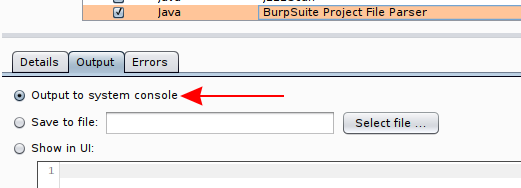burpsuite-project-file-parser is a Burp Suite extension to parse project files from the command line and output the results as JSON. It uses the Montoya Extender API so it should be cleanly compatible with most versions of Burp. Given a project file this can:
- Print all Audit Items
- Print all requests/responses from the proxy history
- Print all requests/responses from the site map
- Given a regex search the response headers or response bodies from the proxy history and site map
Building an AppSec Pipeline with Burp Suite Data
8 Bug Hunting Exampes with burpsuite-project-parser
- Compile the code as described in Build Information
- Install the extension in Burp
- Make sure to set the Output and Errors to system console
- Close Burp Suite and follow examples below to parse the project file.
Notes:
- Flags can be combined. For example, print audit items and site map;
auditItems siteMap; check options below for more information [PATH_TO burpsuite_pro.jar]is required; my path is:~/BurpSuitePro/burpsuite_pro.jarif you need an example.[PATH TO PROJECT FILE]requires a project file and it's recommended to give the full path to the project file- You may need
--add-opens=java.desktop/javax.swing=ALL-UNNAMED --add-opens=java.base/java.lang=ALL-UNNAMEDdepending on your version of Java
The siteMap and proxyHistory flags also support sub-components to speed up parsing. They are:
- request.headers
- request.body
- response.headers
- response.body
So, for example, to print out only the request body and headers from proxyHistory you would use:
java -jar -Djava.awt.headless=true [PATH_TO burpsuite_pro.jar] --project-file=[PATH TO PROJECT FILE] \
proxyHistory.request.headers, proxyHistory.request.bodyThis massively speeds up parsing as the response bodies (which can be quite large) are ignored.
Use the auditItems flag, for example:
java -jar -Djava.awt.headless=true [PATH_TO burpsuite_pro.jar] --project-file=[PATH TO PROJECT FILE] \
auditItems Combine the siteMap and proxyHistory flags to dump out all requests/responses from the site map and proxy history:
java -jar -Djava.awt.headless=true [PATH_TO burpsuite_pro.jar] --project-file=[PATH TO PROJECT FILE] \
siteMap proxyHistory Use the responseHeader=regex flag. For example to search for any nginx or Servlet in response header:
java -jar -Djava.awt.headless=true [PATH_TO burpsuite_pro.jar] --project-file=[PATH TO PROJECT FILE] \
responseHeader='.*(Servlet|nginx).*'
...
{"url":"https://example.com/something.css","header":"x-powered-by: Servlet/3.0"}
{"url":"https://spocs.getpocket.com:443/spocs","header":"Server: nginx"}
...Note, searching through a response body is memory expensive. It is recommended to store requests/responses and search that.
Use the responseBody=regex flag. For example to search for <form elements in response bodies:
java -jar -Djava.awt.headless=true [PATH_TO burpsuite_pro.jar] --project-file=[PATH TO PROJECT FILE] \
responseBody='.*<form.*'If you want to clean up the results to something more manageable (rather than the entire response), YMMV with a second grep pattern for the 80 characters around the match:
java -jar -Djava.awt.headless=true [PATH_TO burpsuite_pro.jar] --project-file=[PATH TO PROJECT FILE] \
responseBody='.*<form.*'| grep -o -P -- "url\":.{0,100}|.{0,80}<form.{0,80}"- Use a custom User Options file (Burp > User options > Save user options) from Burp Suite with only this extension enabled. This can speed up Burp Suite loading speed because only one extension is loaded. Include the
--user-config-fileflag:
java -jar -Djava.awt.headless=true [PATH_TO burpsuite_pro.jar] --project-file=[PATH TO PROJECT FILE] --user-config-file=[PATH TO CONFIG FILE]- Set the max amount of memory used by burp with
-Xmxflag:
java -jar -Djava.awt.headless=true -Xmx2G [PATH_TO burpsuite_pro.jar] --project-file=[PATH TO PROJECT FILE] Run gradle fatJar from the root directory. This expects you have gradle and all dependencies installed.
Build the jar from the Dockerfile.
From the root directory of the project run:
mkdir build
docker build -t burpsuite-project-file-parser .
docker run --name burpsuite-project-file-parser -v [ADD THE FULLPATH TO YOUR CWD]/build:/tmp burpsuite-project-file-parserThe jar file should now be in the build directory of the project.
